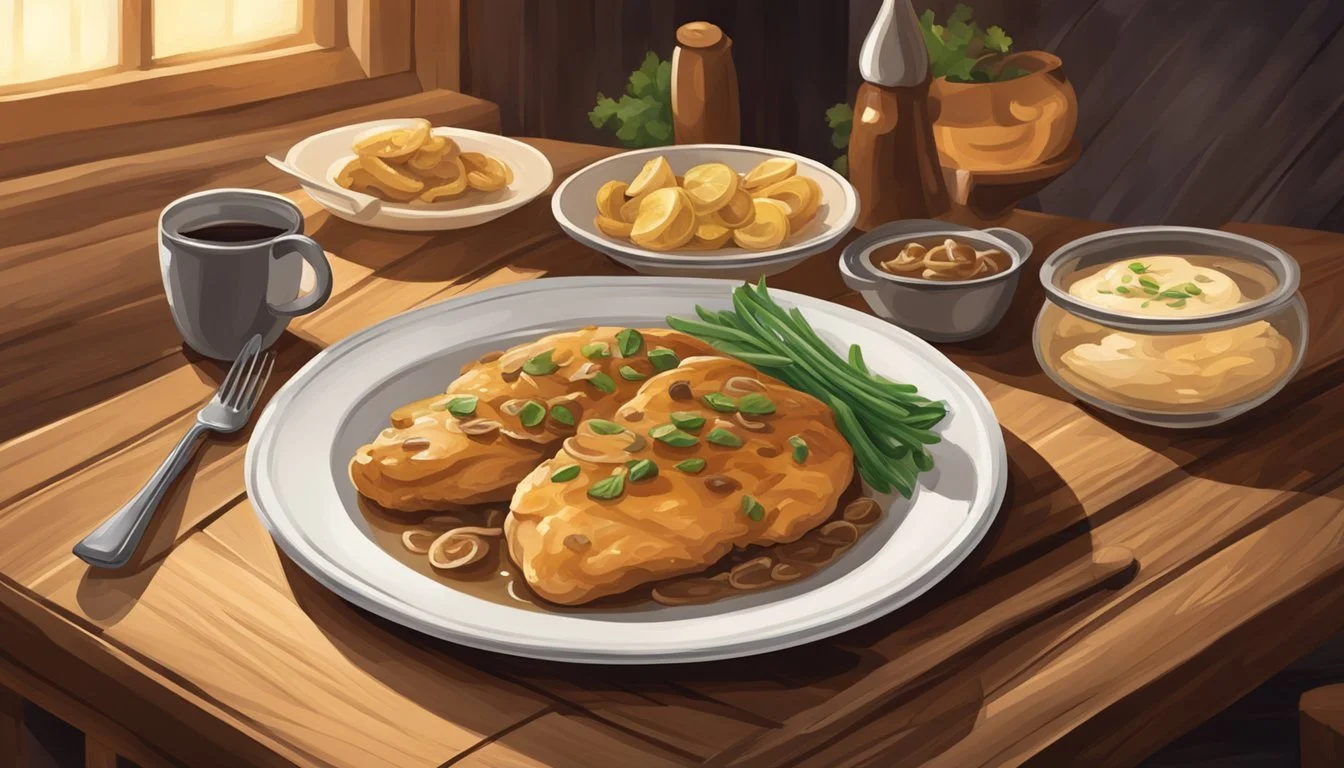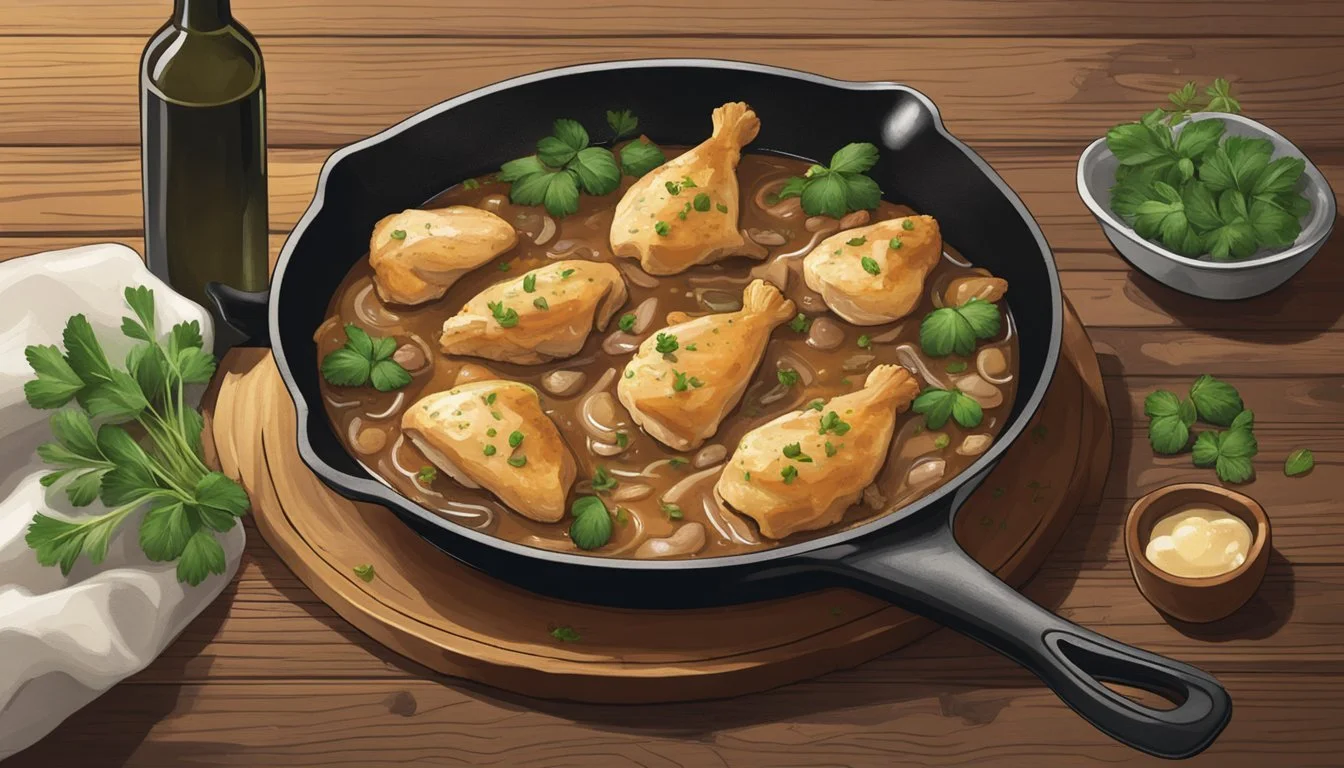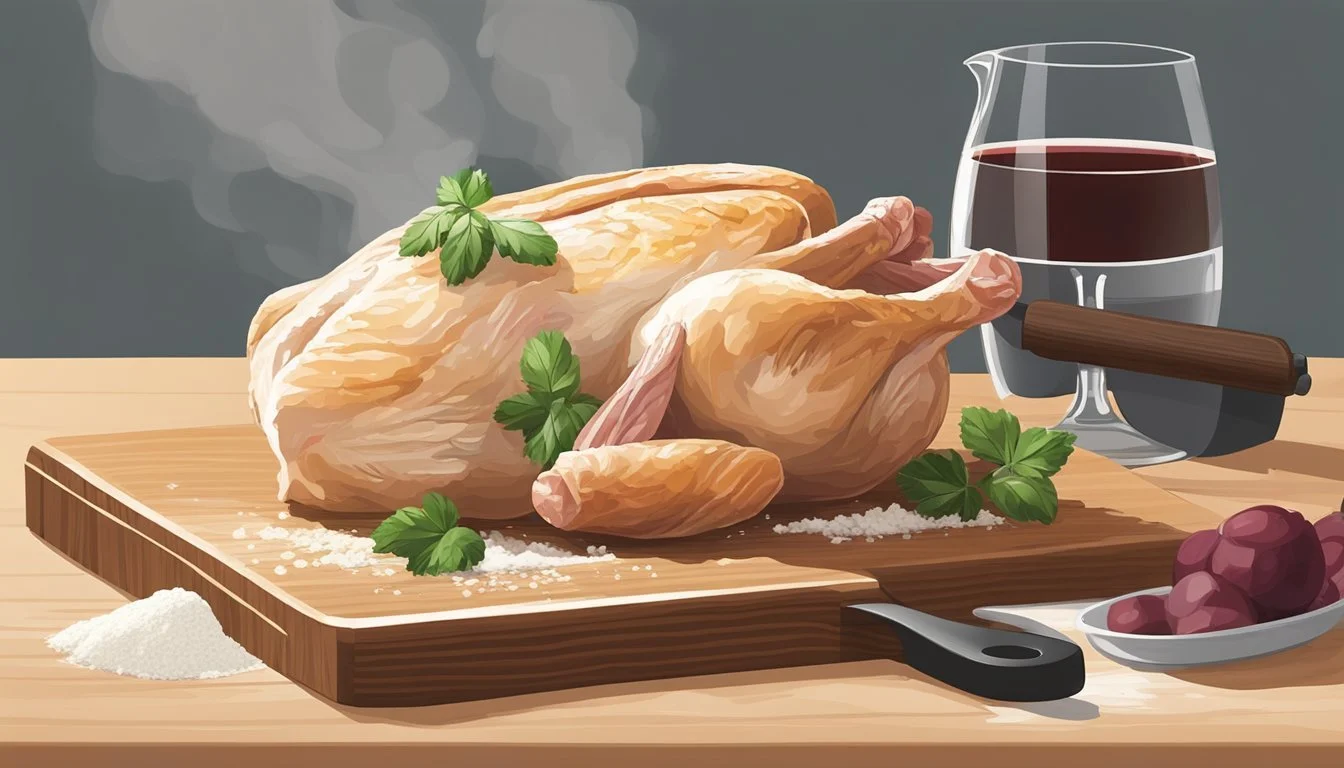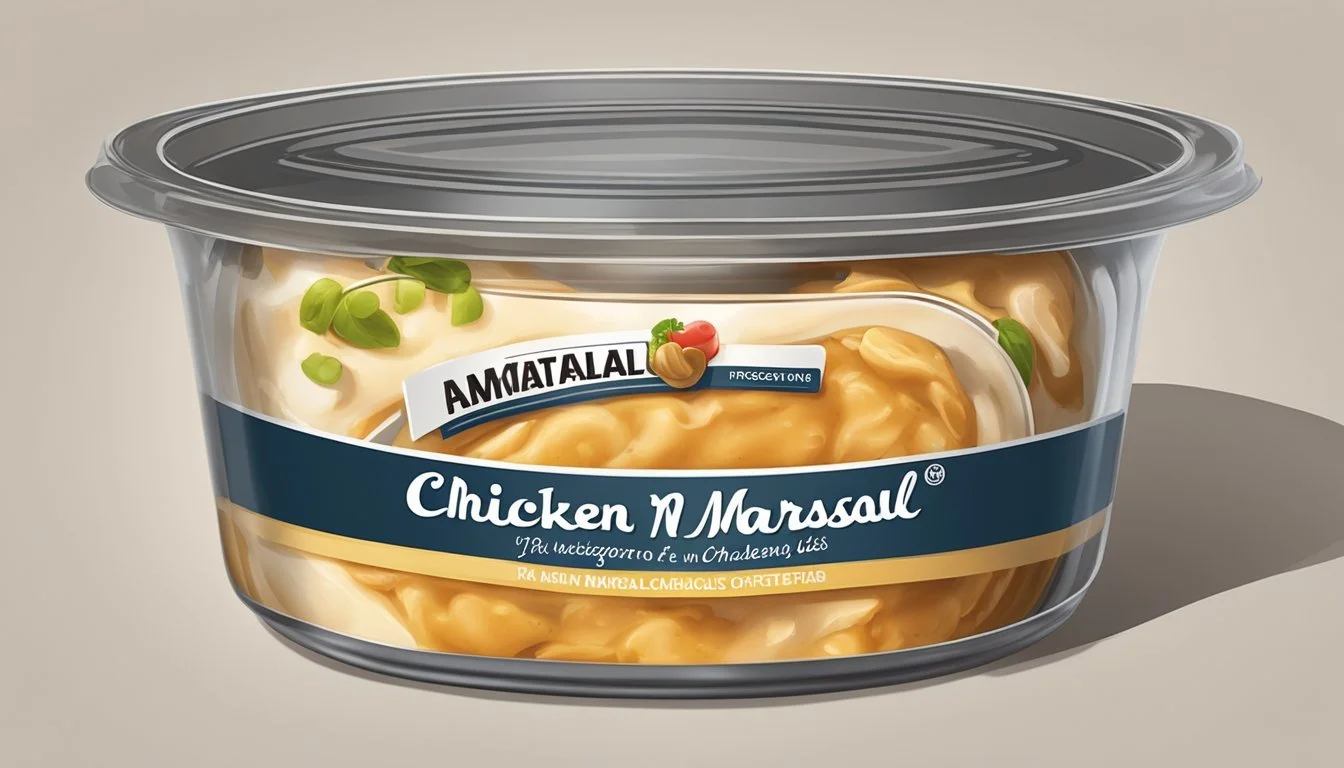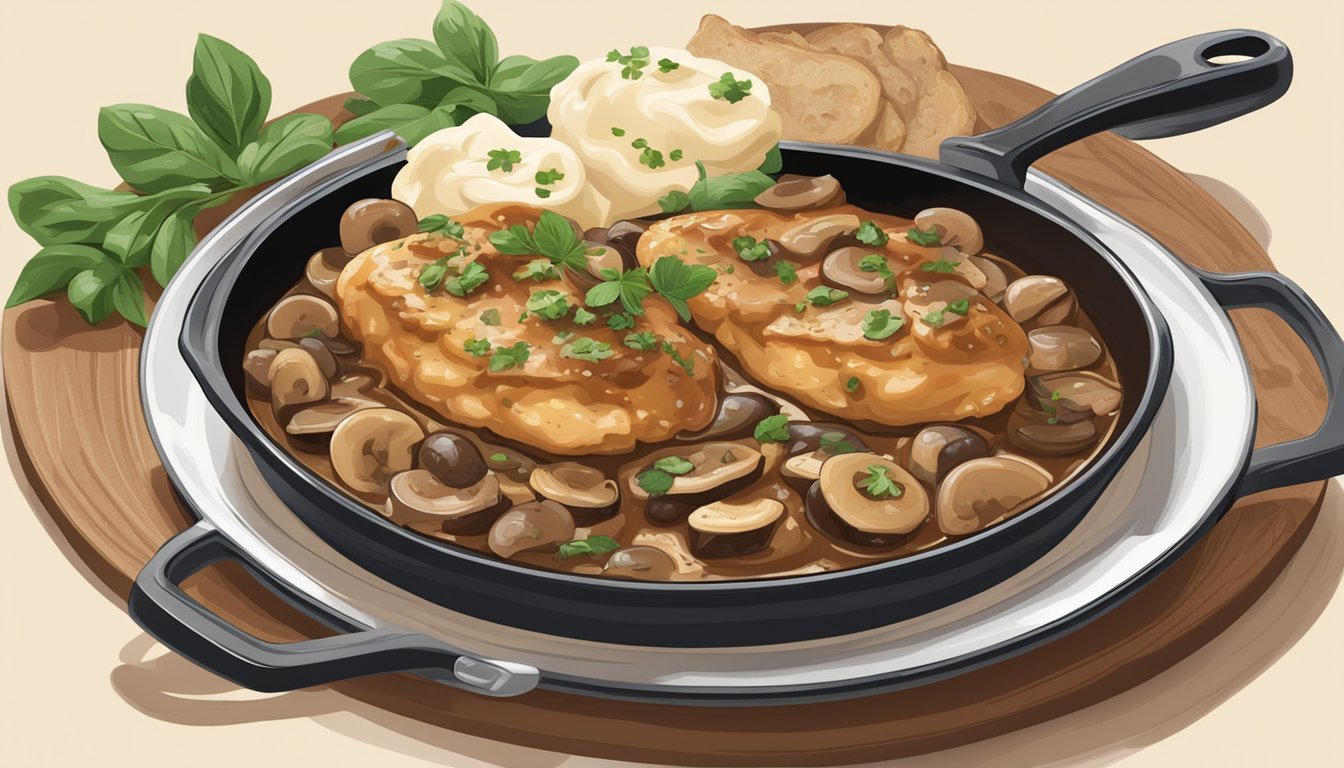How Long Does Chicken Marsala Last?
Storage and Shelf Life Tips
Chicken Marsala, a beloved Italian-American dish, is a favorite for its rich flavors and straightforward preparation. Cooking enthusiasts often find themselves with leftovers and wonder about their shelf life. Leftover Chicken Marsala can be safely stored in the refrigerator for up to three days.
For many, knowing this allows for meal planning and prevents food waste. To safely enjoy this dish for several days after cooking, store it properly and ensure thorough reheating. The dish's taste and quality remain intact within this period, making it a convenient option for busy weeknights.
Understanding the storage guidelines not only ensures safety but also preserves the savory blend of marsala wine and tender chicken. Ensuring the chicken is kept within these recommended time frames can help maintain the dish's delightful flavors and textures.
Understanding Chicken Marsala
Chicken Marsala is a beloved Italian-American dish known for its rich sauce made from Marsala wine. Essential to this recipe are key ingredients like chicken breast, mushrooms, and garlic.
Origins and Popularity
Chicken Marsala traces its roots to Italian cuisine, specifically from the region of Sicily where Marsala wine is produced. It gained popularity in America for its delightful combination of flavors. Restaurants often feature it as a staple, offering a comforting yet sophisticated meal option. The use of Marsala wine, paired with mushrooms and tender chicken breasts, creates a unique taste that is both savory and sweet, making it a favorite among many.
Key Ingredients
Chicken Breast: Typically used for its tenderness, chicken breast is sliced and pounded thin for quick cooking.
Marsala Wine: This fortified wine from Sicily adds depth and a slightly sweet flavor to the dish.
Mushrooms: Button or cremini mushrooms are commonly used, adding earthiness and texture.
Butter and Olive Oil: These fats are essential for frying the chicken and adding richness to the sauce.
Garlic: Minced garlic enhances the sauce with its aromatic and savory notes.
Combining these ingredients in precise measures results in the iconic, flavorful Chicken Marsala enjoyed worldwide.
Preparation Basics
Preparing Chicken Marsala involves selecting the right tools and following essential steps to ensure a flavorful and well-cooked dish. Key elements include properly preparing chicken breasts, using the right cookware, and handling ingredients like Marsala wine and mushrooms effectively.
Essential Tools and Techniques
To make Chicken Marsala, you'll need a few essential tools. A meat mallet is necessary to pound the chicken breasts to an even thickness of about 1/4 inch. This ensures uniform cooking.
All-purpose flour is used to dredge the chicken, providing a light coating that helps achieve a crispy texture when fried. A large skillet is vital, preferably stainless steel, as it provides even browning.
Using a combination of oil and butter helps in achieving the right flavor and browning. A tongs or spatula is useful for turning the chicken pieces and ensuring even cooking. Measuring spoons and cups guarantee the right balance of ingredients.
Step-by-Step Guide
Prepare the Chicken: Place each chicken breast inside a gallon zip-top bag. Use a meat mallet to pound it to an even 1/4-inch thickness. This ensures the chicken cooks evenly and quickly.
Dredge in Flour: Mix all-purpose flour, salt, and pepper in a shallow bowl. Dredge each pounded chicken breast in the flour mixture, shaking off any excess.
Cook the Chicken: Heat oil and butter in a large skillet over medium-high heat. Once the butter has melted, add the floured chicken breasts. Cook for about 2-3 minutes per side until they are golden brown and crispy. Remove and set aside.
Make the Sauce: In the same skillet, add more butter and sliced mushrooms. Sauté until mushrooms are browned, then add Marsala wine. Let it simmer to cook off the alcohol and concentrate the flavors. To make it creamy, you can add heavy cream at this point.
Combine and Serve: Return the browned chicken to the skillet. Let it simmer in the sauce for about 10 minutes to absorb the flavors. Serve immediately with your choice of side.
This detailed preparation ensures your Chicken Marsala will be restaurant-quality right at home.
Serving Suggestions
Chicken Marsala pairs wonderfully with a variety of sides and can be presented elegantly for any occasion. Here are some key suggestions for accompaniments and presentation.
Appropriate Accompaniments
Chicken Marsala shines best when paired with complementary sides. Pasta is a classic choice; fettuccine or angel hair work well to soak up the flavorful sauce. For a creamy balance, mashed potatoes are excellent, providing a rich, comforting texture.
Rice, particularly wild or basmati, offers a lighter yet aromatic alternative. Steamed or sautéed vegetables such as asparagus, broccoli, or green beans add color and balance. Consider a side salad with a light vinaigrette to offset the rich Marsala sauce.
Presentation Tips
To make Chicken Marsala visually appealing, plate it on a large serving platter. Arrange the chicken pieces neatly and drizzle the Marsala sauce generously. Garnish with fresh parsley or thyme for a touch of green.
Serve alongside neatly twirled pasta or a mound of fluffy mashed potatoes. Use shallow bowls for rice and scatter some chopped herbs on top. Ensure each side dish is portioned aesthetically, creating a balanced and inviting plate.
Nutrition Information
Chicken Marsala is a popular Italian-American dish known for its rich flavors. It's important to understand the nutritional content when enjoying this meal.
A typical serving of Chicken Marsala contains approximately 350-400 calories.
Nutritional Breakdown per Serving:
Calories: 350-400
Protein: 38.24g
Fat: 13.47g
Carbohydrates: 10g
Macronutrients:
Proteins: Chicken provides high protein content, essential for muscle growth and repair.
Fats: This dish can be relatively high in fats due to ingredients like butter and oil.
Carbohydrates: Chicken Marsala includes a moderate amount of carbs, mainly from the Marsala wine and any added sides.
Micronutrients:
Salt: Always be mindful of the salt content, especially with added seasonings.
Pepper: Used primarily for flavor, pepper does not significantly affect nutritional values.
Additional Nutrient Considerations:
Vitamins & Minerals: Ingredients such as mushrooms and garlic add extra vitamins and minerals like Vitamin D and potassium.
Sugar: Typically, the sugar content is low but can vary based on the wine and additional ingredients used.
The calorie breakdown may vary based on the recipe and portion size.
Enjoy Chicken Marsala while keeping these nutritional insights in mind to balance your diet effectively.
Storage and Shelf Life
Chicken Marsala can be stored effectively to maintain its quality and taste. Proper refrigeration and freezing are essential to maximize its shelf life and ensure food safety.
Refrigeration Guidelines
After cooking Chicken Marsala, it should be allowed to cool to room temperature before refrigerating. Store the leftovers in an airtight container to prevent odor absorption and moisture loss.
Refrigeration Time: Chicken Marsala can last in the fridge for 3-4 days. Ensure the fridge temperature is maintained at or below 40°F (4°C) for optimal preservation.
Labeling: It’s a good practice to label the container with the date to keep track of its freshness. If the dish shows any signs of spoilage, such as an off smell or unusual texture, it should be discarded immediately.
Freezing and Thawing Instructions
Preparation for Freezing: For longer storage, Chicken Marsala can be frozen. Place the cooled dish in a freezer-safe, airtight container or heavy-duty freezer bag. Remove as much air as possible to prevent freezer burn.
Freezing Duration: Properly stored, Chicken Marsala can be kept in the freezer for up to 2-3 months. It’s crucial to label the container with the date of freezing.
Thawing: To thaw, transfer the container from the freezer to the fridge and let it defrost overnight. For a quicker method, use the defrost setting on the microwave, checking frequently to avoid partial cooking.
Reheating: Once thawed, reheat the Chicken Marsala on the stovetop over medium heat until it reaches an internal temperature of 165°F (74°C). This ensures the dish is hot and safe to consume.
Reheating Recommendations
When reheating Chicken Marsala, it is essential to ensure the chicken is heated evenly and remains moist. There are several methods that can be used, depending on the available appliances and personal preference.
Oven
Preheat the oven to 350°F (175°C).
Place the Chicken Marsala in an oven-safe dish.
Cover the dish with aluminum foil to prevent the sauce from drying out.
Reheat for 15-20 minutes, or until the chicken is heated through.
Microwave
Transfer the Chicken Marsala to a microwave-safe container.
Cover the container loosely with plastic wrap.
Heat on high for 2-3 minutes, stirring halfway through to ensure even heating.
Let it stand for a short while before serving to allow the heat to distribute.
Skillet
Add a small amount of water, broth, or wine to a non-stick skillet.
Place the Chicken Marsala in the skillet and cover it with a lid.
Heat over medium-low heat, stirring occasionally to prevent sticking.
Reheat until the chicken is warmed through, checking and stirring frequently.
Air Fryer
Preheat the air fryer to 350°F (175°C).
Place the Chicken Marsala in the air fryer basket.
Heat for 3-4 minutes, or until thoroughly warmed.
Each method ensures that both the chicken and sauce are reheated properly without compromising the dish's flavor.
Marsala Wine Insights
Marsala wine is a key ingredient in chicken marsala, impacting the taste and quality of the dish. Understanding the differences between types of Marsala and potential substitutes can help ensure the best culinary outcome.
Dry Marsala vs. Sweet Marsala
Marsala wine comes in two main varieties: dry and sweet. Dry Marsala, often used in savory dishes like chicken marsala, adds a robust flavor without overpowering sweetness. It blends well with brandy and enhances the taste of the recipe.
Sweet Marsala is richer and more suited for desserts or sweet sauces. While generally not used in traditional chicken marsala recipes, it can offer a unique twist if substituted carefully. Both types are fortified wines, giving them a higher alcohol content that influences their longevity once opened.
Storage and shelf life are similar for dry and sweet marsalas. When stored in a cool, dark place with a tightly sealed cap, dry or sweet Marsala can last between four to six months after opening. Proper refrigeration extends its flavor profile, ensuring it remains a vital pantry component.
Substitutes and Alternatives
When Marsala wine is unavailable, alternatives can be used without compromising the recipe's integrity. Sherry and Madeira are the closest substitutes. Both are fortified wines that mimic Marsala’s depth and complexity, making them ideal for savory dishes like chicken marsala.
Port wine, although sweeter, can be adjusted by reducing additional sweetness in the recipe. Blending brandy with a small amount of white wine also creates a makeshift substitute that reflects Marsala’s essence. In a pinch, a mix of balsamic vinegar and sugar syrup offers a non-alcoholic alternative, though it lacks the layered flavors of genuine fortified wines.
Having options enriches the cooking experience, allowing for creativity and adaptability in the kitchen.
Health and Safety Considerations
Proper handling of Chicken Marsala is essential to ensure safety and prevent foodborne illnesses.
Once prepared, Chicken Marsala made with chicken breasts should be cooled to room temperature within two hours to avoid bacterial growth. It's recommended to store the leftovers in refrigerator-safe containers.
When storing the dish, make sure the refrigerator is set at or below 40°F (4°C).
Freezing and Thawing
For longer storage, Chicken Marsala can be frozen:
Freeze in airtight containers or freezer bags
Label with the date to keep track
To thaw, move the dish to the refrigerator overnight or use the microwave's defrost setting. Never refreeze after thawing, as this can compromise safety and quality.
Alcohol Considerations
Chicken Marsala often includes alcohol (Marsala wine). While cooking typically reduces alcohol content, it's important for those sensitive to alcohol or avoiding it for medical, religious, or personal reasons to be aware of this ingredient.
Allergen Awareness
Individuals with mushroom allergies should be cautious, as Chicken Marsala traditionally contains mushrooms. It's crucial to check for any potential allergens and modify the recipe accordingly if needed.
Reheating Safety
When reheating Chicken Marsala:
Ensure it reaches an internal temperature of 165°F (74°C).
Stir well to avoid cold spots.
Proper handling and storage ensure that Chicken Marsala remains safe and enjoyable.
Enhancing Your Chicken Marsala
Making Chicken Marsala more delicious and finding creative ways to use leftovers can be simple. This section explores adding extra flavors and inventive uses for leftover Chicken Marsala.
Flavor Boosters and Variations
Adding freshly ground black pepper can elevate the depth of your Chicken Marsala. Try incorporating thyme or oregano for a touch of herbaceous notes.
Heavy cream can make the dish richer, transforming it into a creamy version. Incorporate it toward the end of cooking for a silkier mushroom sauce.
Using different mushrooms such as cremini or shiitake can bring a different texture and flavor. For a touch of color and freshness, garnish with chopped parsley. These tweaks ensure a delightful Italian-American dish that stands out.
Creative Leftover Ideas
Repurpose leftover Chicken Marsala into new and exciting meals. Chicken Marsala Pasta is a great option; shred the chicken and mix it into cooked pasta, reheating with additional sauce if necessary.
Create a Chicken Marsala Panini by layering the chicken and mushroom sauce between slices of crusty bread, then grill until crispy.
Another suggestion is a Marsala Pot Pie; use the leftovers as filling, topped with a puff pastry crust. These ideas ensure leftovers are never boring.
Culinary Techniques
When preparing Chicken Marsala, mastering the Marsala reduction process and achieving perfectly cooked chicken are crucial steps that elevate this dish to new heights.
Marsala Reduction Process
The Marsala reduction process begins with combining Marsala wine and chicken broth in a medium saucepan. Heat this mixture over medium-high heat until it reaches a boil. Once boiling, reduce the heat to medium and allow the sauce to simmer, reducing it until it thickens to around one cup in volume.
This reduction intensifies the flavors of the Marsala wine while integrating with the chicken broth, creating a rich, velvety sauce. Keeping the temperature controlled and stirring occasionally ensures that the flavors meld perfectly and the sauce doesn’t burn. A consistent reduction results in uniform taste and texture.
Achieving Perfectly Cooked Chicken
Start by utilizing boneless, skinless chicken breasts or thighs. Place the chicken pieces between sheets of plastic wrap or inside a gallon zip-top bag. Pound the chicken to an even thickness of about 1/4 inch using a rolling pin or a meat mallet. This not only ensures they cook evenly but also tenderizes the meat.
In a large skillet, melt butter in olive oil over medium heat. Dredge the chicken in seasoned flour before placing it in the skillet. Sauté the chicken until browned on both sides. The browning adds depth of flavor and texture. Cook the chicken thoroughly, making sure it reaches an internal temperature of 165°F.
Properly cooked chicken will be juicy inside and have a crisp, golden-brown exterior, enhancing the overall dish.

